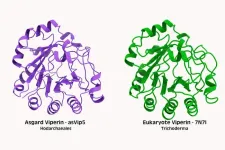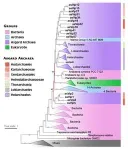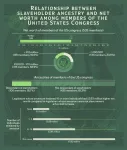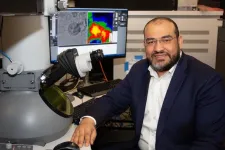(Press-News.org) When you get infected with a virus, some of the first weapons your body deploys to fight it were passed down to us from our microbial ancestors billions of years ago. According to new research from The University of Texas at Austin, two key elements of our innate immune system came from a group of microbes called Asgard archaea.
Specifically, viperins and argonautes, two proteins that are known to play important roles in the immune systems of all complex life — from insects to plants to humans — came from the Asgard archaea. Versions of these defense proteins are also present in bacteria, but the versions in complex life forms are most closely related to those in Asgard archaea, according to the new scientific study published in the journal Nature Communications.
This research bolsters the idea that all complex life, called eukaryotes, arose from a symbiotic relationship between bacteria and Asgard archaea.
“It adds more support to the fact that the Asgards are our microbial ancestors,” said Brett Baker, associate professor of integrative biology and marine science and senior author. “It says that not only did eukaryotes get all these rich structural proteins that we’ve seen before in Asgards, now it’s saying that even some of the defense systems in eukaryotes came from Asgards.”
The researchers identified for the first time a large arsenal of defense systems in archaea that were previously known only in bacteria.
When viperins detect foreign DNA, which might indicate a dangerous virus, they edit the DNA so that the cell can no longer make copies of the DNA, which stops the virus from spreading. When argonautes detect foreign DNA, they chop it up, also halting the virus. Additionally, in more complex organisms, argonautes can block the virus from making proteins in a process called RNA silencing.
“Viral infections are one of the evolutionary pressures that we have had since life began, and it is critical to always have some sort of defense,” said Pedro Leão, now an assistant professor at Radboud University in the Netherlands and a recent postdoctoral researcher in Baker’s lab. “When bacteria and archaea discovered tools that worked, they were passed down and are still part of our first line of defense.”
The researchers compared proteins involved in immunity across the tree of life and found many closely related ones. Then they used an AI tool called ColabFold to predict whether ones that had similar amino acid sequences also had similar three-dimensional shapes (aka structures). (It’s the shape of a protein that determines how it functions.) This showed that variations of the viperin protein probably maintained the same structure and function across the tree of life. They then created a kind of family tree, or phylogeny, of these sister amino acid sequences and structures that showed evolutionary relationships.
Finally, the researchers took viperins from Asgard archaea genomes, cloned them into bacteria (so the bacteria would express the proteins), challenged the bacteria with viruses, and showed that Asgard viperins do in fact provide some protection to the modified bacteria. They survived better than bacteria without the immune proteins.
“This research highlights the integral role cellular defenses must have played from the beginning of both prokaryotic and eukaryotic life,” said Emily Aguilar-Pine, a former undergraduate researcher who contributed to the project. “It also inspires questions about how our modern understanding of eukaryotic immunity can benefit from unraveling some of its most ancient origins.”
“It’s undeniable at this point that Asgard archaea contributed a lot to the complexity that we see in eukaryotes today,” Leão said. “So why wouldn’t they also be involved in the origin of the immune system? We have strong evidence now that this is true.”
Other authors, all from UT, are Mary Little, Kathryn Appler, Daphne Sahaya, Kathryn Currie, Ilya Finkelstein and Valerie De Anda.
This work was supported by the Simons and Moore foundations (via the Moore-Simons Project on the Origin of the Eukaryotic Cell) and The Welch Foundation.
END
Next time you beat a virus, thank your microbial ancestors
Two of our key defenses against viruses have persisted for billions of years, arising before complex life
2024-08-21
ELSE PRESS RELEASES FROM THIS DATE:
Two UCSB professors selected by the Gordon and Betty Moore Foundation to be Experimental Physics Investigators
2024-08-21
(Santa Barbara, Calif.) — UC Santa Barbara professors Andrew Jayich and Jon Schuller have been selected by the Gordon and Betty Moore Foundation to be part of the 2024 cohort of Experimental Physics Investigators. They join 17 other mid-career researchers from around the country, each receiving a five-year, $1.25 million grant to pursue research goals.
“This initiative is designed to support novel and potentially high-payoff projects that will advance the field of physics but might be hard to fund through traditional funding sources,” said Theodore ...
Study of pythons could lead to new therapies for heart disease, other illnesses
2024-08-21
In the first 24 hours after a python devours its massive prey, its heart grows 25%, its cardiac tissue softens dramatically, and the organ squeezes harder and harder to more than double its pulse. Meanwhile, a vast collection of specialized genes kicks into action to help boost the snake’s metabolism fortyfold. Two weeks later, after its feast has been digested, all systems return to normal—its heart remaining just slightly larger, and even stronger, than before.
This extraordinary process, described by CU Boulder researchers this week in the journal PNAS, could ultimately inspire novel treatments for a common human heart condition called cardiac fibrosis, in which ...
Study finds no link between migraine and Parkinson’s disease
2024-08-21
EMBARGOED FOR RELEASE UNTIL 4 P.M. ET, WEDNESDAY, AUGUST 21, 2024
MINNEAPOLIS – Contrary to previous research, a new study of female participants finds no link between migraine and the risk of developing Parkinson’s disease. The study is published in the August 21, 2024, online issue of Neurology®, the medical journal of the American Academy of Neurology.
“These results are reassuring for women who have migraine, which itself causes many burdens, that they don’t have to worry about an increased risk ...
How personality traits might interact to affect self-control
2024-08-21
Neuroticism may moderate the relationship between certain personality traits and self-control, and the interaction effects appear to differ by the type of self-control, according to a study published August 21, 2024 in the open-access journal PLOS ONE by Fredrik Nilsen from the University of Oslo and the Norwegian Defence University, Norway, and colleagues.
Self-control is important for mental and physical health, and certain personality traits are linked to the trait. Previous studies suggest that conscientiousness and extraversion enhance self-control, whereas neuroticism hampers it. However, the link between personality ...
US Congress members’ wealth statistically linked with ancestors’ slaveholding practices
2024-08-21
Per a new study, as of April 2021, US Congress members whose ancestors enslaved 16 or more people had a net worth that was five times higher than that of legislators whose ancestors did not have slaves. Neil Sehgal of the University of Pennsylvania, US, and Ashwini Sehgal of Case Western Reserve University, US present these findings in the open-access journal PLOS ONE on August 21, 2024.
Prior research has linked slavery’s intergenerational effects to contemporary inequality, poverty, education, voting behavior, and life expectancy in the US However, the extent to which past slavery in the US contributes to today’s social and economic conditions remains ...
Following a Mediterranean diet may be associated with reduced risk of COVID-19 infection, per systematic review
2024-08-21
Following a Mediterranean diet may be associated with reduced risk of COVID-19 infection, per systematic review, although it's unclear if the diet is also associated with reduced symptoms and severity of illness.
####
Article URL: https://journals.plos.org/plosone/article?id=10.1371/journal.pone.0301564
Article Title: Relevance of Mediterranean diet as a nutritional strategy in diminishing COVID-19 risk: A systematic review
Author Countries: Indonesia
Funding: The author(s) received no specific funding for this work. END ...
Homicide rates are a major factor in the gap between Black and White life expectancy
2024-08-21
Homicide is a major reason behind lower and more variable reduction in life expectancy for Black rather than White men in recent years, according to a new study published August 21, 2024 in the open-access journal PLOS ONE by Michael Light and Karl Vachuska of the University of Wisconsin-Madison, USA.
The COVID-19 pandemic precipitated a staggering drop in U.S. life expectancy and substantially widened Black-White disparities in lifespan. It also coincided with the largest one-year increase in the U.S. homicide rate in more than a century, with Black men bearing the brunt of these. Despite these trends, there has been limited research on the contribution ...
Human-wildlife overlap expected to increase across more than half of land on Earth by 2070
2024-08-21
ANN ARBOR—As the human population grows, more than half of Earth's land will experience an increasing overlap between humans and animals by 2070, according to a University of Michigan study.
Greater human-wildlife overlap could lead to more conflict between people and animals, say the U-M researchers. But understanding where the overlap is likely to occur—and which animals are likely to interact with humans in specific areas—will be crucial information for urban planners, conservationists and countries that have pledged international conservation commitments. Their findings ...
Freeze-frame: U of A researchers develop world's fastest microscope that can see electrons in motion
2024-08-21
Imagine owning a camera so powerful it can take freeze-frame photographs of a moving electron – an object traveling so fast it could circle the Earth many times in a matter of a second. Researchers at the University of Arizona have developed the world's fastest electron microscope that can do just that.
They believe their work will lead to groundbreaking advancements in physics, chemistry, bioengineering, materials sciences and more.
"When you get the latest version of a smartphone, it comes with a better camera," said Mohammed Hassan, associate professor of physics and optical sciences. "This transmission electron microscope is ...
Study finds highest prediction of sea-level rise unlikely
2024-08-21
In recent years, the news about Earth's climate—from raging wildfires and stronger hurricanes, to devastating floods and searing heat waves—has provided little good news.
A new Dartmouth-led study, however, reports that one of the very worst projections of how high the world's oceans might rise as the planet's polar ice sheets melt is highly unlikely—though it stresses that the accelerating loss of ice from Greenland and Antarctica is nonetheless dire.
The study challenges a new and alarming prediction in the latest high-profile report from the United Nations' Intergovernmental Panel on ...
LAST 30 PRESS RELEASES:
Sleeping in on weekends may help boost teens’ mental health
Study: Teens use cellphones for an hour a day at school
After more than two years of war, Palestinian children are hungry, denied education and “like the living dead”
The untold story of life with Prader-Willi syndrome - according to the siblings who live it
How the parasite that ‘gave up sex’ found more hosts – and why its victory won’t last
When is it time to jump? The boiling frog problem of AI use in physics education
Twitter data reveals partisan divide in understanding why pollen season's getting worse
AI is quick but risky for updating old software
Revolutionizing biosecurity: new multi-omics framework to transform invasive species management
From ancient herb to modern medicine: new review unveils the multi-targeted healing potential of Borago officinalis
Building a global scientific community: Biological Diversity Journal announces dual recruitment of Editorial Board and Youth Editorial Board members
Microbes that break down antibiotics help protect ecosystems under drug pollution
Smart biochar that remembers pollutants offers a new way to clean water and recycle biomass
Rice genes matter more than domestication in shaping plant microbiomes
Ticking time bomb: Some farmers report as many as 70 tick encounters over a 6-month period
Turning garden and crop waste into plastics
Scientists discover ‘platypus galaxies’ in the early universe
Seeing thyroid cancer in a new light: when AI meets label-free imaging in the operating room
Neutrophil-to-lymphocyte ratio may aid risk stratification in depressive disorder
2026 Seismological Society of America Annual Meeting
AI-powered ECG analysis offers promising path for early detection of chronic obstructive pulmonary disease, says Mount Sinai researchers
GIMM uncovers flaws in lab-grown heart cells and paves the way for improved treatments
Cracking the evolutionary code of sleep
Medications could help the aging brain cope with surgery, memory impairment
Back pain linked to worse sleep years later in men over 65, according to study
CDC urges ‘shared decision-making’ on some childhood vaccines; many unclear about what that means
New research finds that an ‘equal treatment’ approach to economic opportunity advertising can backfire
Researchers create shape-shifting, self-navigating microparticles
Science army mobilizes to map US soil microbiome
Researchers develop new tools to turn grain crops into biosensors
[Press-News.org] Next time you beat a virus, thank your microbial ancestorsTwo of our key defenses against viruses have persisted for billions of years, arising before complex life






